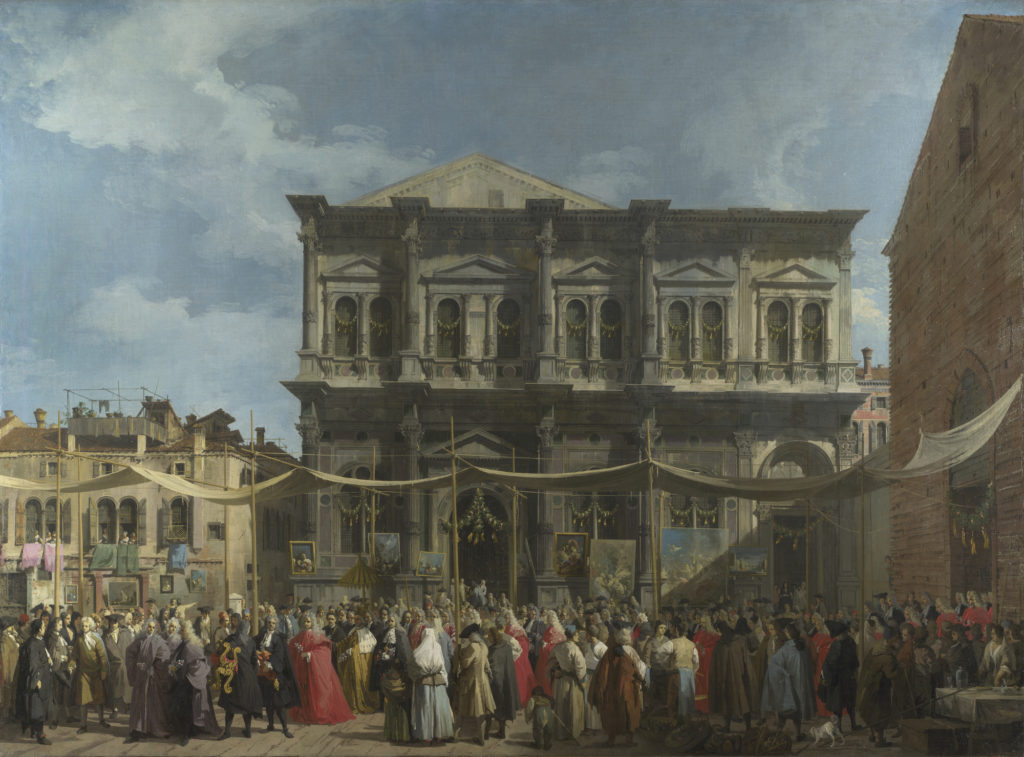Tipped off by none other than Philippe de Montebello, who read my review of Eyewitness Views: Making History in Eighteenth-Century Europe, I learned a fascinating fact about one of the pictures in the exhibition: Canaletto’s The Procession on the Feast Day of Saint Roch is a milestone for contemporary art.
If you look closely at the painting, you’ll see about ten paintings hanging against the the facades of the buildings. I had noticed them, but had not known that “This is one of the first recorded exhibitions of paintings, usually held on a feast day. The pictures would have been removed the next day. And they are contemporary art,” PdM wrote to me. “IÂ use the picture in my history of museums class,” which of course he teaches at NYU’s Institute of Fine Arts.
Here’s a large copy of it:
At the Getty, the label references the paintings:
The procession on the feast day of Saint Roch, who was invoked against the plague, commemorated the end of a devastating outbreak in Venice in 1576. After Mass, the doge and senators (in red togas) leave the church of San Rocco as spectators draw near to watch. Members of the doge’s entourage carry the accoutrements of his office—a ceremonial stool, cushion, and sword. Many participants hold sprigs of flowers, believed to ward off disease. On this annual occasion, an exhibition of paintings was held outside the Scuola di San Rocco.
The National Gallery in London owns the painting, and records the scene this way, adding a line about Titian:
In Venice the feast day of Saint Roch on 16 August commemorated the end of the terrible plague of 1576 (in which Titian died). On this day the Doge would hear mass in San Rocco where Saint Roch was buried, to celebrate his intercession in bringing the plague to an end. Canaletto’s painting shows the grand procession of state dignitaries and ambassadors emerging from the church. The participants all carry nosegays, which were presented to them on arrival as a memorial of the plague. The Doge carries a parasol and wears gold and ermine ceremonial robes. Awnings give protection from the sun.
An exhibition of paintings was traditionally held at the Scuola di San Rocco, which dominates this painting, on Saint Roch’s feast day. The pictures decorating the Scuola here have not been identified.
All intriguing to me, making one of my favorites in the show, even more special. (I love the structure of the painting, bisected by that canopy, and Canaletto’s use of sunlight and shade, along with everything else.)
Speaking of the exhibition, I’ve heard from a few people who said they knew nothing of “view” paintings, though they know about Canaletto and Panini. The other painters in this exhibition are Carlevarijs, Claude Joseph Vernet, Bernardo Bellotto, Antonio Joli, Francesco Battaglioli, Guardi, and Hubert Robert–they were the best of the view painters. With their works, the exhibition takes us to Venice, Naples, Rome,  Siena, Warsaw, Dresden and Madrid.
I should also add that this show will travel to the Minneapolis Institute of Art and to the Cleveland Museum of Art.
Photo Credit: Courtesy of the Getty

